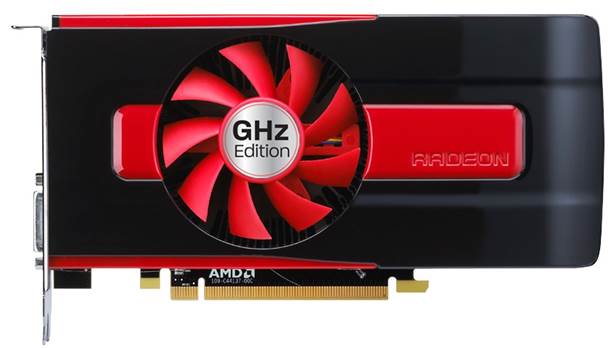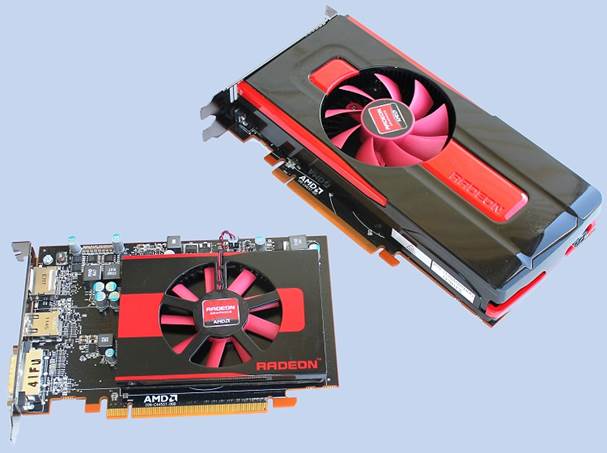While the two pricier AMD chips in this
test have been based around the Pitcairn core, the Radeon HD 7770 is built
around Cape Verde – the lowest-end GPU to be built on the 'Southern Islands'
architecture. That means the Cape Verde architecture has been cut back when
compared to Pitcairn; though the HD 7770 is still built on a 28nm manufacturing
process, it includes just ten of the Graphics Core Next clusters AMD uses as
building blocks for its current cards. In comparison to that, the HD 7870 uses
20, and the HD 7850 includes 16.

AMD
Radeon HD 7770
The stream processor count stands at 640,
half as many as the HD 7870, and there are 1.5 billion transistors. A whopping
1.3 billion less than on the other two AMD cards tested here.
The clock speed sits at a respectable
1,100MHz, though, which is the highest of any card in this test. There’s 2GB of
GDDR5 memory, too, but its 1,125MHz clock is lower than anything else here, and
it also squeezes through a 128-bit bus – half the width of the Pitcairn-based
cards.
Mind you, the price is tempting. At $142,
the HD 7770 costs the same as Nvidia’s GeForce GTX 650, and both cards are the
cheapest in this week’s test. The HD 7770 sits in an interesting position,
though: while it’s the same price as the GTX 650, the more powerful GTX 650 Ti
is just $47 extra.
The HD 7770 puts paid to the GeForce GTX
650 in our benchmarks. In Crysis, the AMD’s 32fps trumped the Nvidia’s 24fps,
and the gap widened in Crysis 2: the HD 7770 scored 35fps, with the Nvidia GPU
nine frames behind. AMD’s architecture scored 40fps in Just Cause 2 and 49fps
in DiRT 3, with Nvidia falling behind with scores of 32fps and 38fps in the
same tests. The HD 7770 scored 43.4fps in Unigine to the GTX 650’s 35.6fps and,
as we’ve seen throughout this test, the AMD card was significantly faster in
3Dmark 11: its combined score of 3,972 trounced Nvidia’s 2,413.
It’s this week’s most frugal card, too. The
HD 7770’s TDP of 80W is only 5W more than PCI Express can handle on its own, so
the one six-pin power connector is barely required at all, and the HD 7770’s
160W peak draw in our test rig is the lowest of all the cards tested here – the
GTX 650 needed 165W, and the GTX 650 Ti required 186W.

MD’s
cheapest mid-range card is only just able to play games at playable framerates
at 1080p: its Crysis and Crysis 2 scores demonstrate its abilities.
When compared to the slightly more
expensive GTX 650 Ti in games, though, the HD 7770 falls behind somewhat: its
32fps Crysis score is beaten by the 40fps scored by the pricier Nvidia card,
it’s also a full ten frames slower in Just Cause 2 and a whopping 20fps behind
in DiRT 3. The gulf is neatly illustrated in our theoretical tests: the HD
7770’s 43.4fps Unigine result and combined 3Dmark 11 score of 3,972 are beaten
by the 55.4fps and 4,094 results of the GTX 650 Ti.
AMD’s cheapest mid-range card is only just
able to play games at playable framerates at 1080p: its Crysis and Crysis 2
scores demonstrate its abilities. That makes it a better buy than the GTX 650,
and the this card earns our recommendation if your budget won’t stretch into
three figures. If you can afford a little more, though, then think about the
GTX 650 Ti – it’s significantly quicker, and the added power means it’ll last
for longer.
The HD 7770 is better than Nvidia’s
similarly priced option and a fine choice if you have to keep the monetary
outlay below three figures.
|
Details
·
Price: $142
·
Website: www.amd.com
Verdict
·
Quality: 6/10
·
Value: 9/10
·
Overall: 8/10
|